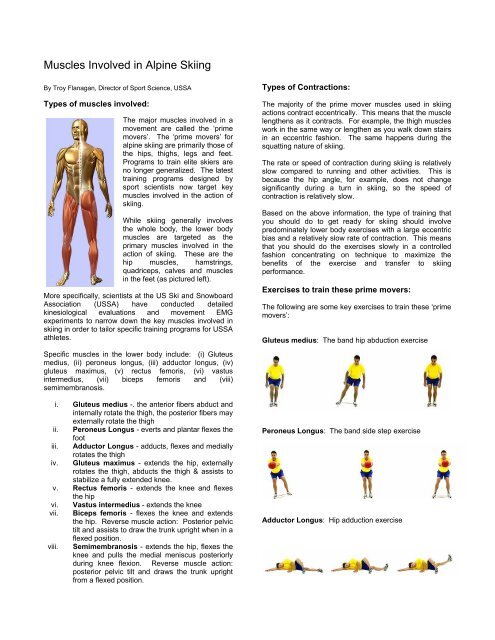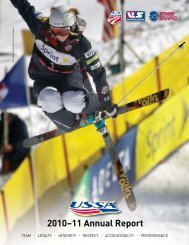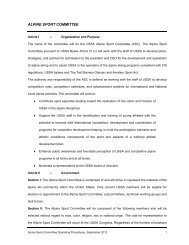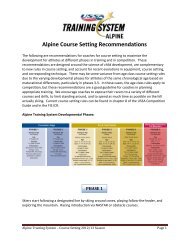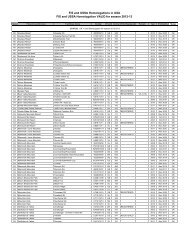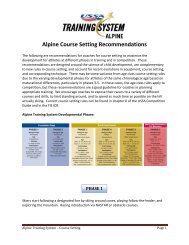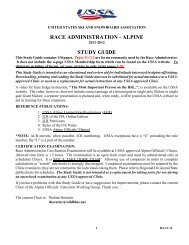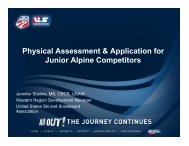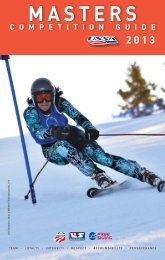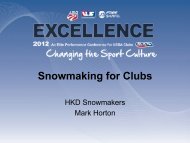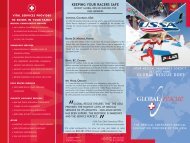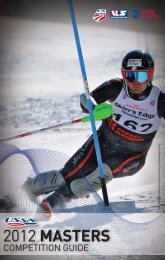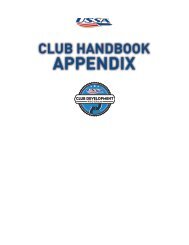Muscles Involved in Alpine Skiing - USSA
Muscles Involved in Alpine Skiing - USSA
Muscles Involved in Alpine Skiing - USSA
Create successful ePaper yourself
Turn your PDF publications into a flip-book with our unique Google optimized e-Paper software.
<strong>Muscles</strong> <strong>Involved</strong> <strong>in</strong> Alp<strong>in</strong>e Ski<strong>in</strong>g<br />
By Troy Flanagan, Director of Sport Science, <strong>USSA</strong><br />
Types of muscles <strong>in</strong>volved:<br />
The major muscles <strong>in</strong>volved <strong>in</strong> a<br />
movement are called the ‘prime<br />
movers’. The ‘prime movers’ for<br />
alp<strong>in</strong>e ski<strong>in</strong>g are primarily those of<br />
the hips, thighs, legs and feet.<br />
Programs to tra<strong>in</strong> elite skiers are<br />
no longer generalized. The latest<br />
tra<strong>in</strong><strong>in</strong>g programs designed by<br />
sport scientists now target key<br />
muscles <strong>in</strong>volved <strong>in</strong> the action of<br />
ski<strong>in</strong>g.<br />
While ski<strong>in</strong>g generally <strong>in</strong>volves<br />
the whole body, the lower body<br />
muscles are targeted as the<br />
primary muscles <strong>in</strong>volved <strong>in</strong> the<br />
action of ski<strong>in</strong>g. These are the<br />
hip muscles, hamstr<strong>in</strong>gs,<br />
quadriceps, calves and muscles<br />
<strong>in</strong> the feet (as pictured left).<br />
More specifically, scientists at the US Ski and Snowboard<br />
Association (<strong>USSA</strong>) have conducted detailed<br />
k<strong>in</strong>esiological evaluations and movement EMG<br />
experiments to narrow down the key muscles <strong>in</strong>volved <strong>in</strong><br />
ski<strong>in</strong>g <strong>in</strong> order to tailor specific tra<strong>in</strong><strong>in</strong>g programs for <strong>USSA</strong><br />
athletes.<br />
Specific muscles <strong>in</strong> the lower body <strong>in</strong>clude: (i) Gluteus<br />
medius, (ii) peroneus longus, (iii) adductor longus, (iv)<br />
gluteus maximus, (v) rectus femoris, (vi) vastus<br />
<strong>in</strong>termedius, (vii) biceps femoris and (viii)<br />
semimembranosis.<br />
i. Gluteus medius -. the anterior fibers abduct and<br />
<strong>in</strong>ternally rotate the thigh, the posterior fibers may<br />
externally rotate the thigh<br />
ii. Peroneus Longus - everts and plantar flexes the<br />
foot<br />
iii. Adductor Longus - adducts, flexes and medially<br />
rotates the thigh<br />
iv. Gluteus maximus - extends the hip, externally<br />
rotates the thigh, abducts the thigh & assists to<br />
stabilize a fully extended knee.<br />
v. Rectus femoris - extends the knee and flexes<br />
the hip<br />
vi.<br />
vii.<br />
viii.<br />
Vastus <strong>in</strong>termedius - extends the knee<br />
Biceps femoris - flexes the knee and extends<br />
the hip. Reverse muscle action: Posterior pelvic<br />
tilt and assists to draw the trunk upright when <strong>in</strong> a<br />
flexed position.<br />
Semimembranosis - extends the hip, flexes the<br />
knee and pulls the medial meniscus posteriorly<br />
dur<strong>in</strong>g knee flexion. Reverse muscle action:<br />
posterior pelvic tilt and draws the trunk upright<br />
from a flexed position.<br />
Types of Contractions:<br />
The majority of the prime mover muscles used <strong>in</strong> ski<strong>in</strong>g<br />
actions contract eccentrically. This means that the muscle<br />
lengthens as it contracts. For example, the thigh muscles<br />
work <strong>in</strong> the same way or lengthen as you walk down stairs<br />
<strong>in</strong> an eccentric fashion. The same happens dur<strong>in</strong>g the<br />
squatt<strong>in</strong>g nature of ski<strong>in</strong>g.<br />
The rate or speed of contraction dur<strong>in</strong>g ski<strong>in</strong>g is relatively<br />
slow compared to runn<strong>in</strong>g and other activities. This is<br />
because the hip angle, for example, does not change<br />
significantly dur<strong>in</strong>g a turn <strong>in</strong> ski<strong>in</strong>g, so the speed of<br />
contraction is relatively slow.<br />
Based on the above <strong>in</strong>formation, the type of tra<strong>in</strong><strong>in</strong>g that<br />
you should do to get ready for ski<strong>in</strong>g should <strong>in</strong>volve<br />
predom<strong>in</strong>ately lower body exercises with a large eccentric<br />
bias and a relatively slow rate of contraction. This means<br />
that you should do the exercises slowly <strong>in</strong> a controlled<br />
fashion concentrat<strong>in</strong>g on technique to maximize the<br />
benefits of the exercise and transfer to ski<strong>in</strong>g<br />
performance.<br />
Exercises to tra<strong>in</strong> these prime movers:<br />
The follow<strong>in</strong>g are some key exercises to tra<strong>in</strong> these ‘prime<br />
movers’:<br />
Gluteus medius: The band hip abduction exercise<br />
Peroneus Longus: The band side step exercise<br />
Adductor Longus: Hip adduction exercise
Gluteus Maximus: Prone hip extension exercise<br />
Rectus Femoris: Cable kick exercise<br />
Vastus <strong>in</strong>termedius: Stability ball deep squat exercise<br />
Biceps Femoris: Cable leg curl exercise<br />
Semimembranosis: Cable hip extension exercise<br />
Remember that perform<strong>in</strong>g exercises <strong>in</strong>correctly can be<br />
detrimental to your health. Consult your medical doctor<br />
before beg<strong>in</strong>n<strong>in</strong>g any new exercise program.<br />
For more <strong>in</strong>formation, CD Roms and DVDs on how to<br />
prepare for the upcom<strong>in</strong>g ski season, visit the <strong>USSA</strong><br />
website: http://education.ussa.org ■


